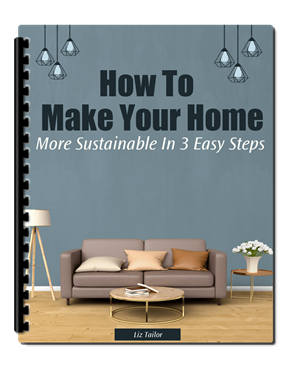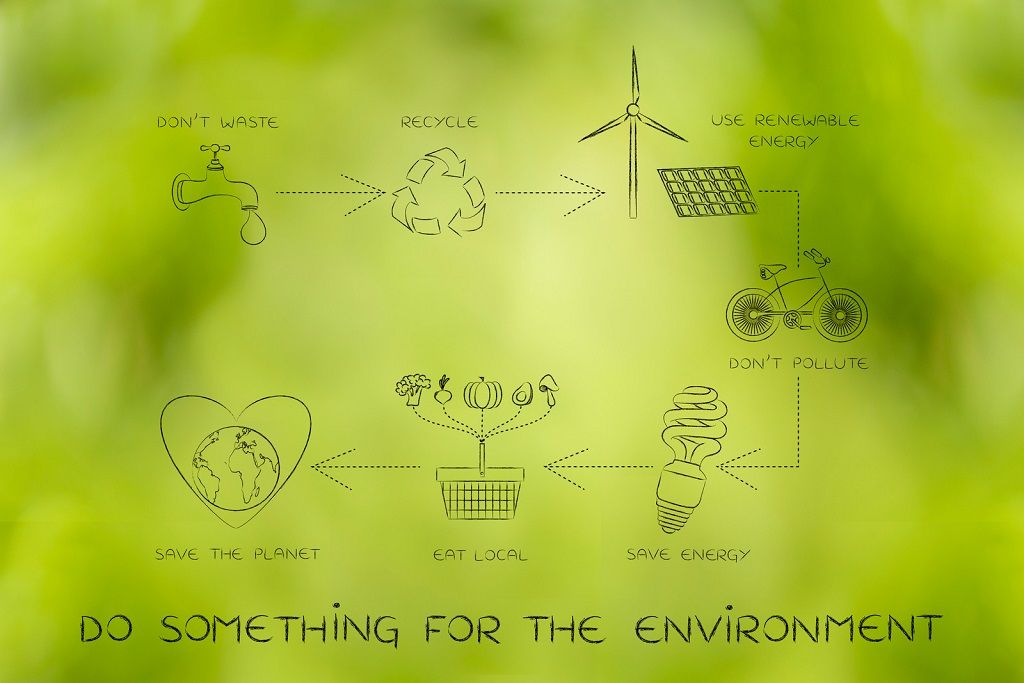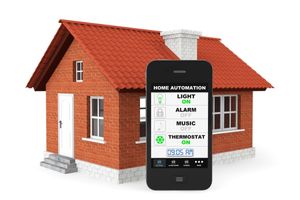It’s no secret that if we continue to ignore all the ecological signs that the earth is showing us, we’ll eventually experience cataclysmic events that will negatively affect us all.
Since we collectively contribute to the destruction of our planet, we must collectively be a part of the solution to slow down or completely eliminate its erosion.
You recycle. You buy organic foods whenever possible and you try to combine your errands so you don’t use too much fuel.
Maybe you carpool to work and occasionally buy and sell from consignment stores. Sustainability is on your radar.
You want to be a responsible citizen that takes care of the planet and does what you can to live an environmentally friendly lifestyle.
When it comes to sustainability there is a balance.
Most people want to do more to live an eco-friendly life, but they also want to make sure that it doesn’t consume all of their time, energy, and money.
For example, there’s a difference between starting a garden and converting your entire household's energy to solar power.
One requires a few hours a week of your time and the other may require several months of renovations and a change in energy consumption that you may not be prepared for.
So how do you know where that balance is? How do you know if you’re doing as much as you can without dramatically changing the way you live your life?
Are You Ready to Take Sustainability to the Next Level?
Sustainability is a lifestyle. As you take steps to live a greener life, you’ll make changes to your lifestyle.
Are you ready for some changes?
Let’s take a look at a few questions.
The answers will guide you to your next steps.
How Organized Are You?
Do you find that you often create systems to organize your life, your space, and your daily routine?
For example, do you occasionally re-organize the pantry or create chore charts for yourself or your children?
If you’re often creating systems, that means you’re fully capable of tackling a more sustainable life.
You might even have what it takes to take on a larger project or lifestyle change.
Are You Ready for a Change?
Change can be good. It keeps you fresh, it challenges your mindset and your mental processes.
It helps you grow. Adopting a new sustainability project, habit, or system requires a willingness to change.
If you feel like you’re ready for change and can get excited about it, then you’re ready to take sustainability to the next level.
Are You Looking to Feel More Fulfilled, Rewarded, and Engaged?
Living a sustainable lifestyle is rewarding. Sure, some projects are hard work but that work pays off.
You’ll feel more engaged in life and in your community.
You’ll also enjoy a feeling of satisfaction when you know that your new habits do have a positive impact on the world.
If you answered yes to any of these questions then you’re ready to take sustainability to the next level.
Don’t worry; you don’t have to go off the grid if you don’t want to.
Over the remaining pages you’ll learn eight different ideas to add more sustainable habits and projects to your life.
Choose one or all eight - it’s up to you.
Let’s get started with composting…
Sustainability Idea #1: Composting
What do you do with your vegetable scraps? What about your banana peels, coffee grounds, or eggshells?
Whether you have a garden or not, you can turn that everyday kitchen garbage into compost.
Compost is nature's recycling program. Materials decompose and turn into extremely fertile and rich soil.
You can use the compost around your plants, and in your houseplants, and of course, you can add it to your lawn or garden.
While adding composting to your lifestyle does require adopting a few new habits, it’s actually pretty easy to incorporate into the way you live.
Step 1: Obtain Two Containers
You’ll need two containers. You’ll need a composting bin or area outside.
You’ll also need something to store your kitchen waste in.
For outdoors, there are different types of bins to consider.
Some have a handle on them so you can turn the bin and mix your compost.
Others allow you to pop off the top.
You mix by hand using a rake or shovel.
For indoors, you want to choose a ceramic or stainless steel container. You’ll want it to have a lid.
Step 2: Start Your Compost
Outside you’ll want to position your compost bin in an area where it will be out of your way but convenient.
Start your compost with a layer of brown material.
Brown material is anything that is dry like twigs, dry leaves, straw, or dried grass.
You’ll want this material to be a few inches thick.
Inside, you can start collecting your kitchen waste.
In general, don’t compost any meat, grease, or material that has animal waste on it.
You can compost cardboard, fruits and vegetables, eggshells, coffee and tea grounds, and newspapers.
If you aren’t sure, play it safe, and don’t add it to your compost.
A word of warning: if you add seeds to your compost, for example, apple or tomato seeds, don’t be surprised to find plants growing in your compost, or later in your yard where you’ve placed the compost.
When your indoor container is full, add it to your outdoor compost bin and mix it up.
Step 3: Evaluate and Maintain
Your compost needs to stay moist but not soak.
If it gets too wet, it will mold.
If it’s too dry, nothing will happen.
You can add water to your compost if it’s looking dry.
Stir your compost every couple of weeks.
Turning or stirring aerates it, which facilitates decomposition.
Yard and food waste make up more than 30% of the waste in our landfills.
When you compost your kitchen and yard trimmings, you’re helping to divert that waste from the landfill.
It’s a great way to live a more sustainable life.
Sustainability Idea #2: Raising Chickens
More and more people in cities, suburbs, and the country are raising chickens.
They’re relatively easy to keep and the daily fresh eggs are quite a treat.
It’s becoming so common that you can probably find the chicken feed at your local home store.
This is of course a bigger project than composting but it’s not as huge of an undertaking as you might think.
Step 1: Find Out If It’s Legal To Keep Chickens
The first step is to see if you can legally keep chickens in your area.
Check city and neighborhood laws and ordinances.
If you live in an HOA community there may be rules that say you can’t keep animals/livestock on your property.
Some cities limit the number of chickens you can keep.
Step 2: Choose Your Breed
Before you build a chicken coup or plan their area, decide what type of chickens you want to keep.
Consider looking for breeds that lay a lot of eggs so you can get more bang for your cluck.
Hybrid chickens tend to lay more eggs and they’re generally easier to raise, which is great for beginners.
Also, look for birds that are gentler in personality so you don’t have to worry about being chased out of the henhouse.
Step 3: Build or Buy Your Chicken Coop
A chicken coop serves several purposes.
It keeps your chickens warm when the weather turns.
It protects them from predators.
It also gives them a happy place to lay their eggs.
Make sure the coop is well-ventilated.
You’ll need nesting boxes, roosting poles, a place for food and water, and bedding material.
Step 4: Feed Your Chicks
You can buy chicken feed at your local hardware or farm supply store.
It’s a well-rounded material that provides your chickens with the nutrition they need.
You might also give them some scratches and some kitchen scraps.
Make sure they have fresh water and create a system to keep the water flowing.
You can buy automatic waterers for chickens.
Step 5: Room to Roam
Create a fenced-in area where your chickens can roam and stretch their legs.
Keep in mind that the area where they’re able to roam will get scratched up pretty quickly.
If you can rotate where you let them roam, you can prevent completely destroying your yard.
This also helps prevent boredom.
Yep, chickens get bored.
Raising chickens is an adventure.
Talk to other chicken owners to learn more about the best breeds and how they’ve managed their flocks.
And then enjoy the daily fresh eggs you get and the fun of raising chickens.
Next, we’re going to step it up and take sustainable living to another level by talking about switching to alternative energy sources.
Sustainability Idea #3: Embracing Alternative Energy
One way to make a huge impact on your energy bill and on the environment is to begin using alternative energy in your home.
Some states may still offer a tax credit for installing alternative energy systems.
Step 1: Choose Your Approach
There are several different alternative energy sources to consider.
The most popular are solar and wind.
Solar is generally considered the easiest option and the most affordable.
Most experts agree that solar panels and systems have never been cheaper.
Fully installed, your solar array might cost around $3 per watt.
The average four-kilowatt system then costs around $12,000 for the entire system.
However, that doesn’t include tax credits and savings.
Over 20 years experts predict the average family could save around $20,000.
Wind and hydro systems are other options.
However, they’re generally more expensive and more difficult to maintain.
Solar is durable and lasts for decades with minimal maintenance.
Step 2: Identify Your Budget and Goals
Decide what you want to accomplish from your alternative energy.
For example, if you simply want to recharge your devices without having to a plugin, you can invest in small solar charging appliances.
If you want to go completely independent and create all your own power, you’ll want to take the next step.
Step 3: Get Quotes and Price It Out
There are two general approaches.
You can reach out to local installation companies who can give you the full package.
This often includes connecting you to the grid so you can earn energy credits.
Or you can install your system yourself.
Step 4: Install and Enjoy
Get your system installed and create a plan to maintain it.
Now you can enjoy the fruits of your labor for decades.
For fun, track your monthly savings by comparing your new energy bill to last year's.
The next sustainable living idea also embraces the resources that nature provides.
Let’s take a look at how to harvest your rainwater.
Sustainability Idea #4: Harvesting Rainwater
You don’t have to be dealing with a drought to enjoy the sustainability benefits of harvesting rainwater.
If you are in a drought then you know that the hassle of alternating watering days can wreak havoc on your garden and landscaping.
However, even if you’re not in the midst of a drought, a rainwater harvesting system is a great way to reduce your water consumption.
Rainwater harvesting reduces stress on local aquifers and rivers.
When you reduce stress, more water is available to help sustain aquatic life.
Step 1: Review Your Home Codes and Laws
Make sure you can install a rainwater harvesting system.
Some communities don’t allow this and some home organizations have strict guidelines on what your system can and cannot contain.
Make sure you understand the rules and take them into consideration for the next step.
Step 2: Design Your System
The simplest system simply takes the rainwater from your downspout.
You can buy rain barrels from your local home improvement store or you can create your own.
If you only have room or a budget for one rain barrel, study your home’s roofline and downspout system to identify the best place to collect water.
You may find that one area of your roof gets the most flow.
You’ll gather the most water in this area.
Step 3: How Will You Use the Water?
It’s important to create a system where you’re using rainwater.
If it’s allowed to sit, you’ll start growing things and collecting bugs.
In fact, it’s a great place for mosquitos to reproduce.
You can attach a garden hose to your rain barrel and use it to water your garden.
You can also create a drip irrigation system from your rain barrel.
Or you can simply fill watering cans from it and use the water to hydrate your plants both indoors and out.
Finally, take the time to occasionally clean out your rain barrel.
Empty it completely and clean out the leaves and debris.
You’ll be amazed how much dirt and material can come off your roof, through your downspouts, and into your rain barrel.
By cleaning it out, you’ll ensure that the flow remains strong and that you don’t start growing bacteria or fungus in your barrel.
Harvesting your rainwater is just one simple way you can take your sustainable lifestyle to the next level.
You’ll become more conscious of your water consumption.
Don’t be surprised if you never throw a glass of water down the drain ever again.
We’re going to take a slight detour with the next idea and talk about fun ways to give back to your community and enjoy a more sustainable lifestyle.
Sustainability Idea #5: Fun Ways To Give Back And Live Sustainably
For many, part of living sustainably is creating a sense of community.
It’s not just a lifestyle; it’s a movement.
It’s a collective approach to making the world a better place and that doesn’t just stop with environmental steps.
It can include other methods of working with others.
Let’s take a look at three fun ways to give back, live sustainably, and enjoy a simpler lifestyle.
Join a CSA
CSA stands for Community Supported Agriculture. Essentially, CSA members buy shares of a farm and receive the benefits.
When you buy a share, the benefits include whatever the farm produces.
Some farms focus solely on growing produce.
You’ll receive weekly bundles of lettuce, onions, and tomatoes in the summer months, and squash and dark leafy greens in the fall.
Other farms might sell shares of the livestock they have on the farm.
You might get eggs from chickens, milk from goats, or meat from a cow at the end of the year.
Some farms sell partial shares which are good for small families.
Whole shares might provide enough weekly produce to feed a large family or multiple families. CSAs are fun because it creates a community.
Everyone is welcome to pitch in at the farm, though you don’t have to.
You create a routine of visiting the farm and picking up your fresh organic produce.
They’re great for the local economy and excellent for the environment as most CSAs are organic farms.
Additionally, you’re not buying products that had to be shipped from another country to your supermarket, so you’re cutting back on your carbon footprint.
Join a Food Co-Op
A food co-op or cooperative is an organized grocery store.
Members help decide what items are carried in the store and where they come from.
In exchange, they also get reduced prices.
Most often, items in the market come from local farmers and local companies.
You have the ability to buy materials in bulk and save money.
Co-operatives can be fun because you’re part of a community of decision-makers.
It’s a lifestyle that many people enjoy.
Grow a Community Garden
Another option to enjoy a simpler lifestyle while giving back is to participate in or start a community garden.
This type of initiative works well in suburban or urban environments where green space may be limited.
Find a plot of land, get permission from the city, and then invite others to participate in the tending of the garden.
Those who help out and give their time are able to enjoy the fruits of their labor.
It’s also a great way to get children involved in the growing process and to help them understand how plants grow and how food is produced.
Finally, if all of these ideas are a bit too time-consuming or they’re unavailable in your area, consider creating a weekly outing to your local farmer’s market.
You can enjoy the time outside with your friends and family and support local farmers at the same time.
And you just can’t beat the flavor and nutrition of locally-grown produce.
The next idea takes a look at how to reduce food waste. You’ll not only help create a better environment, but you’ll also save money too.
Sustainability Idea #6: Reduce Your Food Waste
You might be surprised to learn that in the United States, more than 34 million tons of food go to waste on an annual basis.
And that accounts for around 14 percent of the total waste.
The vast majority of this garbage goes into landfills where it decomposes and creates greenhouse gases.
The U.S. Department of Agriculture estimates that people in the U.S. waste about 27 percent of their food.
So what can you do to reduce your food waste?
Keep in mind that by reducing the amount of food you throw away, you’re actually saving money too.
The following tips and lifestyle changes will help you make sure very little goes to waste.
Meal Planning
Sit down once or twice a week and plan your meals.
Plan what you need for breakfasts, lunches, and dinners.
Create a list and then shop from the list. Buy only what you need.
When you’re making the list, keep the recipes in front of you so you can make sure you buy the right quantity.
For example, if a stir fry recipe calls for 10 ounces of chicken, you can buy only around 10 ounces.
Learn to Love Leftovers
Much of the food that goes to waste in your home is probably due to leftovers.
Either change your meal planning so you don’t have leftovers or learn to love them.
For example, leftover stir fry may not sound like a typical breakfast, but it can be quite satisfying.
Or use them for your packed lunch.
Learn to Preserve
There are many different opportunities to preserve your produce before it goes bad.
For example, if you buy an abundance of apples and can’t eat them all before they go bad, you can chop them up and freeze them.
You can place them in a food dehydrator or a low-temperature oven and make dried apple slices.
You can also cook them down and toss them in a food processor and make applesauce or apple butter.
Finally, if you just can’t do anything with that food and it’s going to end up in a landfill, consider composting.
We've discussed it already in this article.
Composting turns your food scraps and paper scraps into rich soil that you can use in your garden, landscaping, or even in your indoor plants.
It’s a smart way to help keep waste out of landfills and to reduce your food waste.
Next time we’ll talk about conserving energy and reducing your energy bills.
It’s a simple and powerful lifestyle change.
Sustainability Idea #7: The Lowdown on LEDs
This sustainability idea is a super easy one.
However, the initial financial output may be more than you’d like to take on.
We’re talking about switching all of your home’s light bulbs to LED bulbs.
Why Switch?
According to the EPA, and the Environmental Protection Agency, if every household in the United States replaced just one standard incandescent light bulb with an energy-efficient one, the nation would save about $600 million in annual energy costs.
That’s enough to power three million homes for a year.
You might also be surprised to learn that lighting your home typically accounts for about 20-30 percent of your electric bill.
If you have a $50 monthly electric bill, that’s a savings of about $150 annually.
But Aren’t LED Bulbs Expensive?
The truth is that when compared to a 99-cent incandescent light bulb, a $25 bulb may seem outrageous.
However, here’s the thing.
That $25 bulb will last twenty years or more, which brings it down to about a dollar a bulb annually.
And that incandescent bulb that you buy will probably need to be replaced in four to six months.
So you’re actually spending a bit more annually on incandescent bulbs than on LED, but it’s negligible.
The real savings is in the annual energy savings.
A Strategic Approach
If you’re not excited about spending a thousand dollars or more replacing every single light bulb in your home, then you might enjoy this frugal strategy.
Step 1: Identify Your Priority Lights
What lights do you use the most?
Chances are they’re in your kitchen and living room.
This is where you spend the most time each day and where the lights are on more than in any other room.
Replace these lights first.
Step 2: Buy In Bulk
In many cases, you’ll be able to save a bit on LED bulbs if you buy them in multipacks.
Make sure you’re buying the right size bulb for your fixture.
Make the appropriate lumens to watts conversion (there’s usually a conversion printed on the packaging).
Look also for the appropriate size base.
For example, some lights have pins at the base and others have screw bottoms.
Also, choose the right size and shape of bulb.
There’s nothing more frustrating than getting a bulb home and realizing it peeks out above your light shade.
It’s unattractive and irritating.
Step 3: Keep An Eye Out For Sales And Coupons
Make a list of the next priority room and keep an eye out for sales and coupons.
More and more stores, including your local supermarket, carry LED bulbs so you should be able to find some savings.
LED bulbs are a simple way to live a more sustainable life.
Add them to your home in a way that makes the most financial sense for you.
For the last idea, we’ll shift away from light and talk a bit about saving more water.
Sustainability Idea #8: How to Save More Water
It seems like at any given time, half the country is dealing with a drought.
Even if you’re not in a drought, it makes good environmental sense to save as much water as possible.
Now that doesn’t mean you have to go without showering; your friends and family would probably not appreciate that degree of effort.
However, there are other lifestyle changes and steps you can take to conserve water.
And you’ll cut down on your water bill too. Saving money is always good.
Step 1: Install a Low Flow Shower Head
Low flow doesn’t mean that your showers will be weak and unsatisfying.
In fact, there are many powerful low-flow showers that make you feel like you’re in a spa.
Older model showerheads generally have a flow rate of about five to eight gallons per minute.
A low-flow showerhead uses about one and a half to two and a half gallons per minute.
Simply unscrew your old model and attach the new model, then enjoy the savings.
Step 2: Xeriscape
Xeriscaping is the process of using plants in your landscaping that doesn’t need much water.
And we’re not just talking about cacti and succulents.
There’s actually quite a large selection of plants that are drought-friendly.
If xeriscaping isn’t your style, consider watering your lawn in a more conservative manner.
Water every couple of days and water your lawn when the sun goes down.
Water it for a solid twenty to thirty minutes to give it a good soaking.
This helps the roots go deeper and they’ll be able to retrieve more water down deep instead of relying on surface water.
Step 3: Laundry and Dishes
Only do complete loads of laundry and dishes.
Don’t run the appliances when they’re less than full.
The same is true when you’re hand-washing laundry or clothes.
Fill the sink instead of letting the water run.
Every little step you can take to conserve water helps the environment.
The changes don’t have to be monumental to make a difference.
Install a low-flow toilet, take shorter showers, and pour any leftover water into plants. Be water-wise!
Making A Smooth Transition Into A Sustainable Lifestyle
There are so many ways to make a difference in the world and the environment.
From composting to installing a solar panel system in your home to provide your energy, there are so many options it might seem overwhelming.
How do you decide where to start and more importantly - once you’ve decided, how do you make the transition a smooth one?
Step 1: Prioritize and Plan
Choose one new habit or one area of your life where you want to make a change.
What’s the most important change you feel capable of tackling right now?
Where do you think you can make the biggest difference?
For example, maybe you want to start eating more organic and locally grown foods.
Once you’ve decided what’s most important to you, consider how you can accomplish your goals.
For example, if you want to eat more organic and locally grown foods you might join a CSA, add a garden to your yard, or visit the local farmer’s market to get your produce.
This helps you add organic and locally grown produce to your daily life.
It also helps cut down on emissions and your carbon footprint because the food you’re buying doesn’t have to travel far to get to your table.
Step 2: Make Small Changes
Decide what you can do and take small steps.
Your changes and goals should be realistic and achievable.
For example, maybe gardening isn’t really something you have time for but you can visit the farmer’s market once a week.
That’s a realistic goal that you can achieve.
Step 3: Be Patient and Persistent
Finally, keep in mind that it takes a few weeks to create a habit.
Every step you take to live a more sustainable life is a positive step.
Be patient with yourself and persistent in your life changes.
Conclusion
After discovering the 8 Sustainable Living Ideas For Beginners, are you ready to get started?
At the beginning of this article, we stated that we collectively contribute to the destruction of our planet, and we must collectively be a part of the solution.
What you’ve learned today is just a starting point to get you moving in the right direction to begin your sustainable lifestyle journey.
We’re proud of the fact that you’re interested in doing your part to preserve Mother Earth!
Download Our Free E-book!







